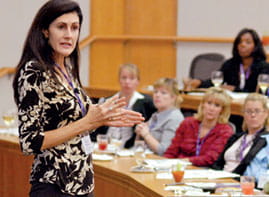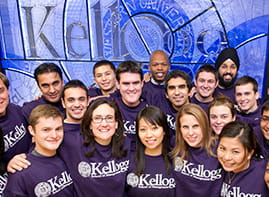Kellogg’s first-ever Computational Social Science Summit features collaboration and human-machine partnerships
5/29/2015 - The application of big and new data to social science questions requires partnerships — not only between humans and machine, but also among different disciplines.
That need for collaboration, on both fronts, was the theme behind Kellogg’s inaugural Computational Social Science Summit (CSSS), held May 15-17 on Northwestern’s Evanston campus.
The three-day conference brought together participants from the social, computer and natural sciences to explore how machine learning can find new insight within the realm of social science.
“There is deep stuff behind all of this: identity, language, how we communicate, and how meaning is embedded in symbols,” said
Brian Uzzi, the Richard L. Thomas Professor of Leadership and Organizational Change and Co-Director, Northwestern Institute on Complex Systems.
Here are a few highlights from the event:
IBM Watson’s lead: humans and machines might make good partners
The future of computational social science — and society as a whole — will rely on human and machine learning partnerships, say keynote speakers David Ferrucci of Bridgewater Associates and Kellogg Professor
Moran Cerf.
Ferrucci should know. He led the development of IBM’s Watson, the cognitive computing system that beat the best human champions on the quiz show “Jeopardy!” He argued that smart computers and artificial intelligence could become valuable partners in decision-making. How? By deriving insights from unstructured data that might be otherwise inaccessible to humans.
On the other hand, Cerf discussed the potential of machines to bring us closer to ourselves, specifically to our brains. A neuroscientist and associate professor of marketing, Cerf examined how information from the brain could be used to predict future action.
That data, Cerf said, could also teach people how to better collaborate with others, as well as their own unconscious, decision-making processes.
“All of this is drives the big push forward into man-plus-machine partnerships,” Uzzi, said, “where machine learning can make us be better decision makers, be happier, and be healthier.”
Datathon showcases collaboration across disciplines
As it grows, computational social science will require many domains of expertise and a willingness to cross traditional boundaries.
These cross-disciplinary partnerships were on full display during the Datathon, a 24-hour competition where teams examined actual Chicago municipal and crime data to find meaningful insight.
“I didn’t want the computer scientists to have all the fun, and I might have been the first person to have that thought,” said Laura Norén, Moore/Sloan Post Doctoral Associate for the Center for Data Science at New York University, who organized the datathon.
Computational Social Science is also on the forefront of exploring the potential of cross-disciplinary collaboration to any field, said keynote speaker Katy Börner, adding that computational social science research could speed up the spread of good ideas and facilitate global partnerships.
“Long distance interdisciplinary partnerships lead to higher scientific impact,” she said. “Interdisciplinary pairs drive win-win exposure where papers get higher citations than they otherwise would.”
Partnering computation with theory
This way of thinking counters past notions that computational work is unhelpful to existing theory or makes it obsolete. Rather, conversations at the summit focused on the potential of both to strengthen each other.
Keynote Michael Macy argued that big data was the “telescope” that social scientists have been searching for, a tool that theory could direct.
“The more data we have to sift through, the more we need to know where to look," Macy said, adding that it was up to social science disciplines to ask the meaningful questions big data could substantiate. Macy’s message was simple: that “big data” is actually “new data,” and it’s the valuable grist for important questions.
Keynote Sandra González-Bailón examined the relationship between social network usage at protests, asking: “Do social networks connect separate protests? Do social networks facilitate the spread of protests globally?"
She suggested that studying networks would reveal important connections that may have been ignored by theory that lacked measurable data.
Related reading






